The Radeon RX 6800 XT and the GeForce RTX 3080 are among the best GPUs on the market, and with good reason. It’s been years since AMD has competed with Nvidia in the high-end range of GPUs, and they did a great job when they released the 6800 XT, but let’s find out how they truly compare to each other in this 6800 XT vs 3080 comparison.
6800XT vs 3080 – Quick Comparison
AMD made a huge leap forward with the Radeon RX 6000 series, which is based on its RDNA2 architecture (we’ll go into that later). You can feel the difference between it and their previous generation in terms of performance, Ray Tracing, and DirectX 12 Ultimate API support. This provided the GeForce RTX 3080 with some strong competition.
When the Nvidia GeForce RTX 3080 was first released, it improved on Nvidia’s former generation with flying colors, bringing 4K gaming to the masses. These improvements proved to be the biggest generational leap in GPU power seen in a long time. Taking just that into account brings out the AMD 6800 XT’s leap forward even more.
| Specs | Radeon 6800XT | GeForce RTX 3080 |
|---|---|---|
| GPU | Navi 21 XT(215-121000177) | GA102-200-KD-A1 |
| Interface | PCIe 4.0 x16 | PCIe 4.0 x16 |
| Architecture | RDNA 2.0 | Ampere |
| GPU Cores | 8,960 Stream Processors | 8,704 CUDA Cores |
| Tensor Cores | N/A | 272 |
| RT Cores | 72 Ray Accelerators | 68 Gen 2 RT cores |
| Base Clock | 1,825 MHz | 1,440 MHz |
| Game Clock | 2,015 MHz | N/A |
| Boost Clock | 2,250 MHz | 1,710 MHz |
| Memory Type | GDDR6 | GDDR6X |
| Memory Size | 16 GB | 10 GB 12 GB |
| Memory Speed | 2,000 MHz | 1,188 MHz |
| Bandwidth | 512.0 GB/s | 760.3 GB/s |
| Memory BUS | 256-bit | 320-bit |
| TDP | 300 W | 320 W |
| Suggested PSU | 700 W | 750 W |
| Outputs | 1x HDMI 2.1 2x DisplayPort 1.4a 1x USB Type-C | 1x HDMI 2.1 3x DisplayPort 1.4a |
| Price | Check Price on Amazon | Check Price on Amazon |
AMD Radeon RX 6800XT
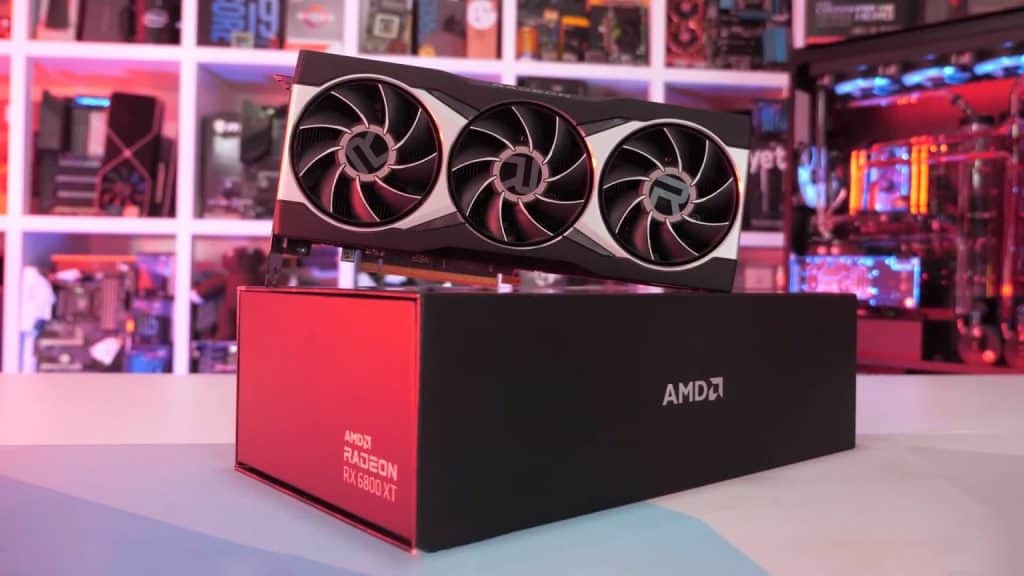
AMD was founded way back in 1969 in Silicon Valley, growing into one of the leading global companies when it comes to CPUs, GPUs, cloud infrastructures, and so on. Although their CPUs were always among the best, their GPUs struggled to keep up with the high-end competition for some time.
This changed the moment they released the 6800 XT. It offers great performance on all levels compared to its Nvidia counterpart. Most reports have verified that the 6800 XT almost matches the RTX 3080 in most games.
Pros:
- 4K performance
- Cheaper than the 3080
- Cooler performance
- Large GDDR6 capacity
Cons:
- Moderate Ray Tracing performance
- Slower than the 3080 at 4K
Nvidia GeForce RTX 3080
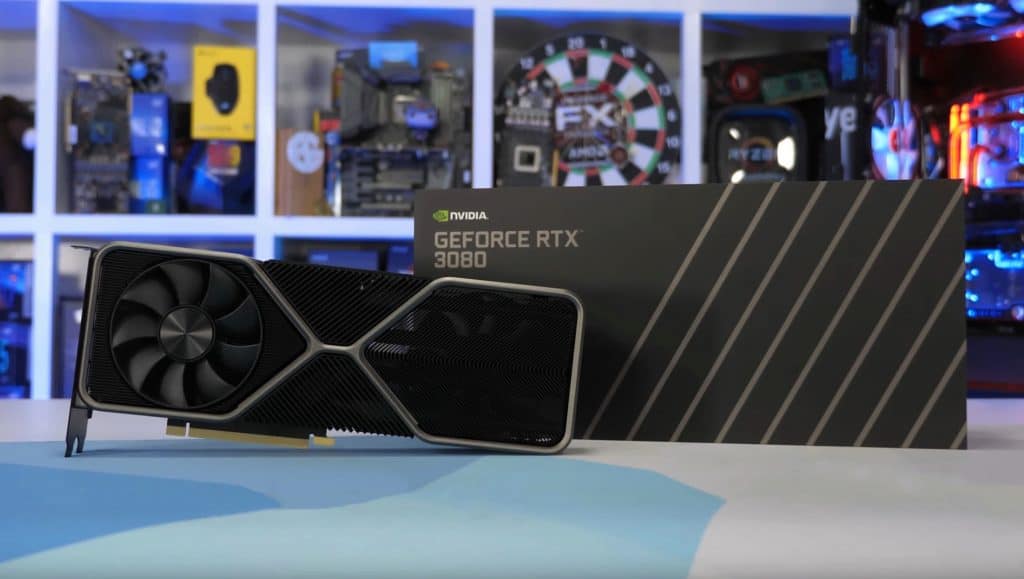
Nvidia was founded back in 1993 successfully predicting the expansion of the PC gaming industry that came years later. Their GPUs are now the brains behind computers, robots, self-driving cars, and some really cool AI tech Nvidia is working on. Their GPUs are also the backbone of most crypto-mining operations.
Pros:
- Excellent 4K gaming performance
- Low temperatures
- Plenty of useful non-gaming features
- Faster than the 6800 XT
Cons:
- Slightly higher price tag than the 6800 XT
- No USB-C in Founders Edition
6800XT vs 3080 – Key Specifications
Architecture
The Radeon 6800 XT is based on AMD’s RDNA 2 architecture, as is its entire RX 6000 series of GPUs. AMD claims that this architecture delivers up to 65% more performance per watt compared to its previous generation – RDNA. The RDNA 2 introduced AMD Infinity Cache, enabling high bandwidth performance at low power and latency.
AMD’s RDNA 2 also utilizes Smart Access Memory (something Nvidia was only working on at the time). Smart Access Memory (SAM) refers to the CPU’s ability to better access GPU VRAM. The previous series allowed the CPU to access only 256MB of memory at a time. AMD has removed that limitation, allowing the CPU to access the entire high-speed GPU memory.
This means your games will run faster when compared to using previous AMD GPUs, with bandwidth reaching 512 Gbps. The GPU has 26,800 million transistors and DirectX 12 Ultimate capabilities that guarantee it will support many upcoming games.
Compared to the GeForce RTX 3080, AMD’s architecture seems to fall short on paper. The RTX 3080 is based on Nvidia’s Ampere architecture, which is used for much more than just gaming. Ampere is the leading computational engine powering the AI revolution, so running your Cyberpunk is more like walking it in the park for the RTX 3080.
So, if the 6800 XT runs fast, you can be sure the RTX 3080 runs even faster, with bandwidth reaching 760.3 Gbps and a slightly larger GPU with 28,300 million transistors. Nevertheless, AMD produces both GPUs and CPUs and motherboards specifically designed for gaming, so a rig with an entire AMD ecosystem would likely win in gaming alone.
Winner: Nvidia GeForce RTX 3080
Clock Speeds & Overclocking
The 6800 XT has a base speed above the 3080, which seems to be the reason why it can compete with the RTX 3080 at all. Its base speed is 1,825 MHz, compared to GeForce’s 1,440 MHz. The 6800 XT vs 3080 also wins in boost clock, with 2,250 MHz compared to 1,710 MHz, respectively.
Boost clocking is a form of (automatic) overclocking, but it’s not the same as manual overclocking. Manual overclock allows you to fiddle around with the settings of your graphics card to get more out of it, but it’s not something to be taken lightly. Overclocking can send your card into (dangerous) high temperatures, which can shorten its lifespan.
That said, manual overclocking doesn’t always mean better results. You can check these test results for more details on overclocking the 6800 XT, or these results for details on overclocking the RTX 3080. When overclocking, one thing to keep in mind is to maximize the fan speed to keep the temperatures down.
The best way to overclock your AMD 6800 XT is by using the AMD software (instructions here). The best way to overclock your Nvidia RTX 3080 is by using Nvidia’s software and looking under the performance tab. Many people use the MSI Afterburner software as well.
Almost all third-party variants come factory overclocked. The top five variants of each card according to their boost clock are listed below.
| RX 6800 XT | Boost Clock | RTX 3080 | Boost Clock |
|---|---|---|---|
| ASRock RX 6800 XT Taichi X OC | 2,360 MHz | ASUS ROG STRIX RTX 3080 GAMING OC | 1,905 MHz |
| ASUS ROG STRIX LC RX 6800 XT GAMING OC | 2,360 MHz | ASUS ROG STRIX RTX 3080 GUNDAM | 1,905 MHz |
| ASUS ROG STRIX RX 6800 XT GAMING OC | 2,360 MHz | ASUS ROG STRIX RTX 3080 V2 GAMING OC | 1,905 MHz |
| Dataland RX 6800 XT Ares X | 2,360 MHz | Colorful iGame RTX 3080 Vulcan X OC | 1,905 MHz |
| PowerColor Liquid Devil RX 6800 XT | 2,360 MHz | GIGABYTE AORUS RTX 3080 XTREME | 1,905 MHz |
Winner: AMD Radeon RX 6800 XT
Cores
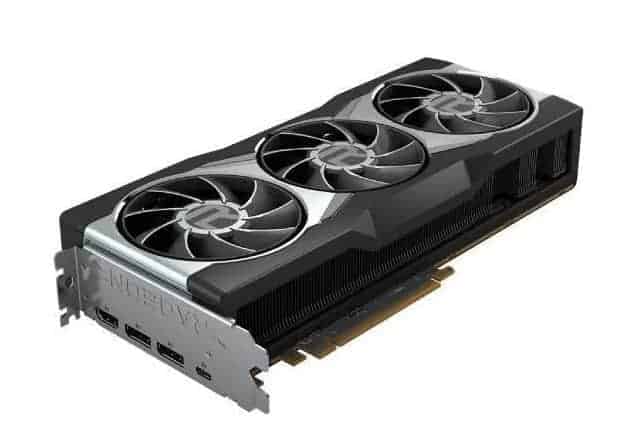
A CUDA (Compute Unified Device Architecture) core processes the numerous calculations required by the GPU. Essentially, the more cores in your GPU, the greater the benefit to you as a user. They handle aspects such as lighting and shadows, physics, certain types of anti-aliasing, and ambient occlusion.
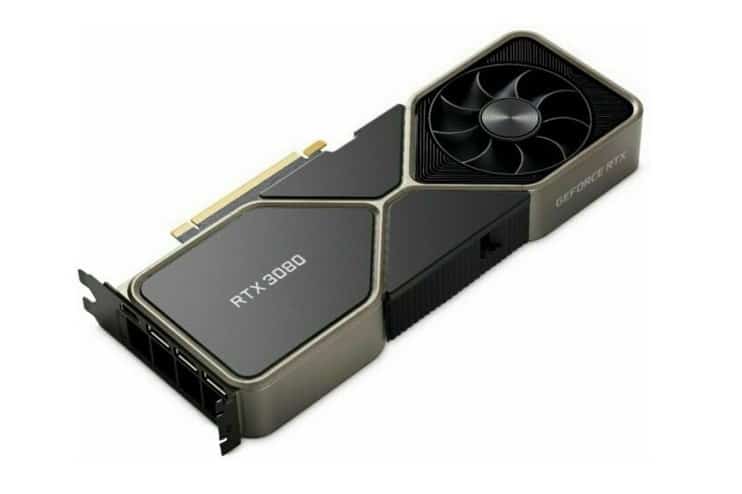
What Nvidia calls CUDA cores, AMD calls Stream Processors, but they’re the same thing fundamentally and function-wise. Nvidia has a slight advantage in this department simply due to its higher core count.
Winner: Nvidia GeForce RTX 3080
VRAM & Memory Specs
The base 3080 model was released with 10GB of GDDRX6 memory, with a later version having 12GB. As far as GPU memories go, that’s great, especially as the GDDR6X memory of the 3080 is faster than the regular GDDR6 memory of the 6800 XT. 10GB of VRAM still runs most 4K games, but some titles might soon come out that will need more. That’s where the 6080 XT comes in.
AMD decided to go the extra mile by releasing the RTX 6800 XT with a whopping 16GB of GDDR6 memory rendering it more future-proof. While Nvidia relies on faster memories, AMD relies heavily on its overclocking to get the results they’re after. This, coupled with its Infinity Cache and impressive hardware, certainly gives the 3080 a run for its money.
The current configurations of these two cards still have tests going in Nvidia’s favor, even with its smaller VRAM size.
Winner: AMD Radeon RX 6800 XT
Shaders, RT Cores, and TMUs
AMD includes a single Ray Accelerator on each compute unit, offering a total of 72 in the RX 6800 XT. Whatever marketing departments say about how using accelerators instead of RT Cores is okay, the difference is obvious. RT Cores are dedicated cores with a single function, while Ray Accelerators are part of the overall Compute Unit structure in RDNA 2.
Nvidia is on its second-generation RT Cores with Ampere, bringing a lot of improvements under the hood with it, making it superior to AMD’s architecture. AMD brought its hardware support to DirectX 12 levels, but the RTX 3080 still outperforms it in most benchmark tests. Even the previous GeForce RTX 2080 Ti model beats the 6800 XT in this regard.
| Shaders | 6800 XT | RTX 3080 |
|---|---|---|
| DirectX | 12 Ultimate (12_2) | 12 Ultimate (12_2) |
| OpenGL | 4.6 | 4.6 |
| OpenCL | 2.1 | 3.0 |
| Vulkan | 1.3 | 1.3 |
| Shader Model | 6.7 | 6.6 |
Shader tests are also in Nvidia’s favor. The RT Cores offload the SMs (streaming multiprocessors), allowing them to handle vertex, pixel, shading, and other graphical and computational workloads.
Winner: Nvidia GeForce RTX 3080
Performance and Resolutions
If we were to rely on game benchmark tests alone, we’d see a notable performance advantage for the RX 6800 XT. I always prefer to take a look at user tests and Effective Frames per second (EFps), and they tell quite a different story this time.
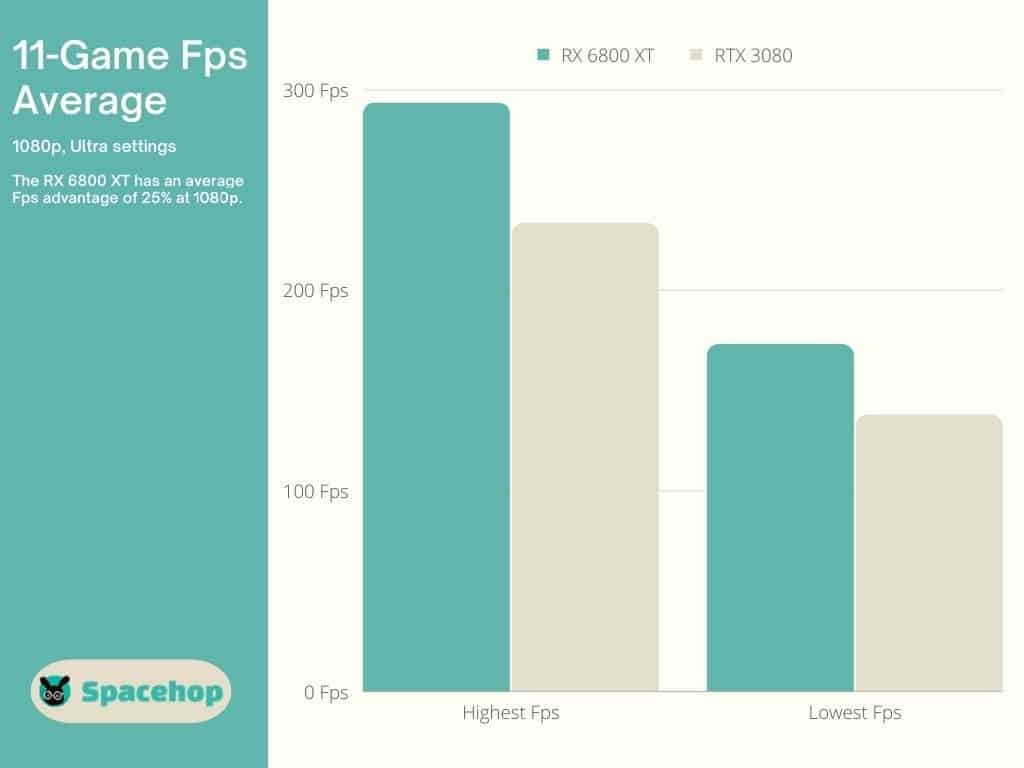
Benchmark tests show a 25% advantage for the RX 6800 XT at 1080p.
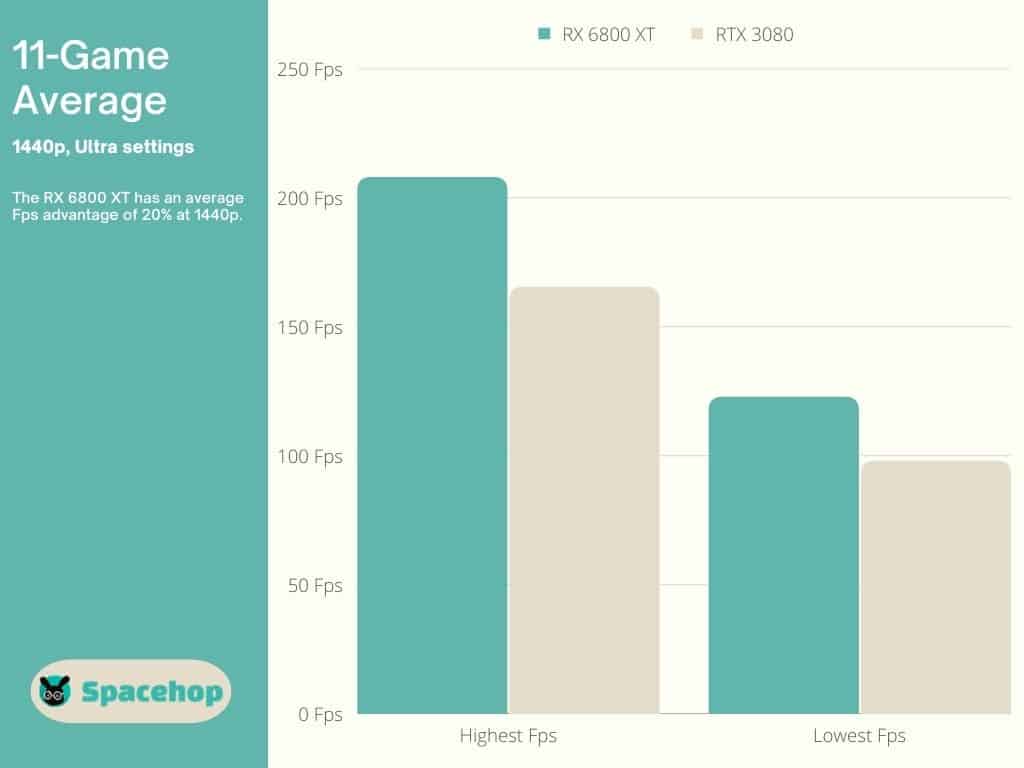
Benchmark tests show a 20% advantage for the RX 6800 XT at 1440p.
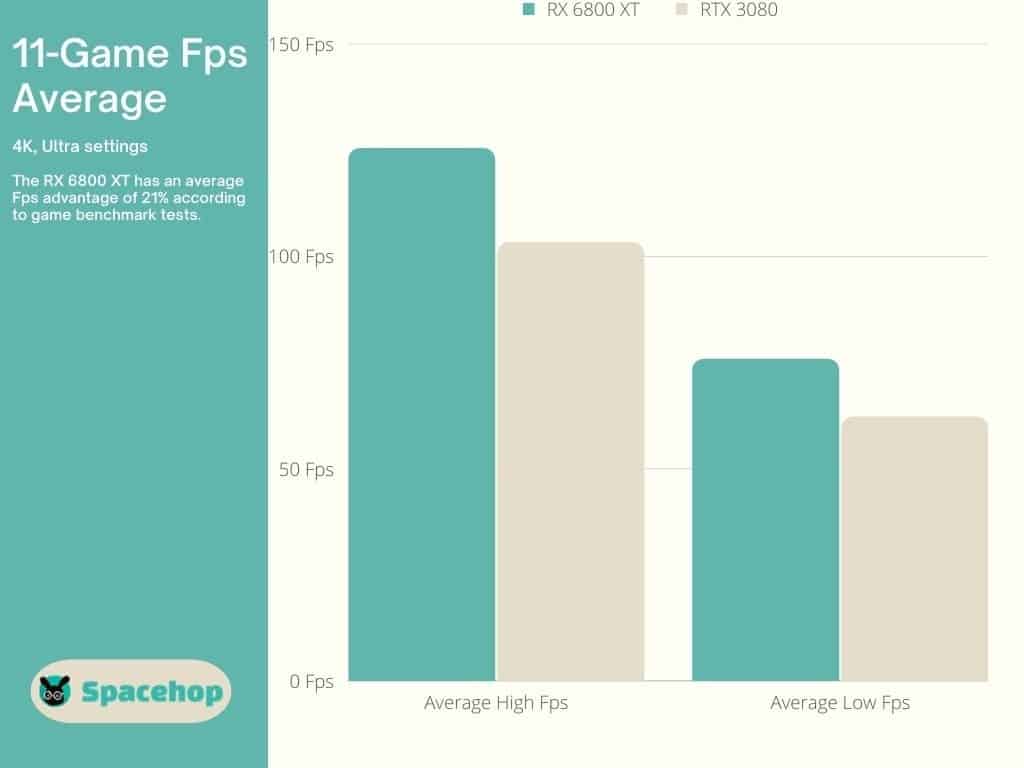
Benchmark tests show a 21% advantage for the RX 6800 XT at 4K.
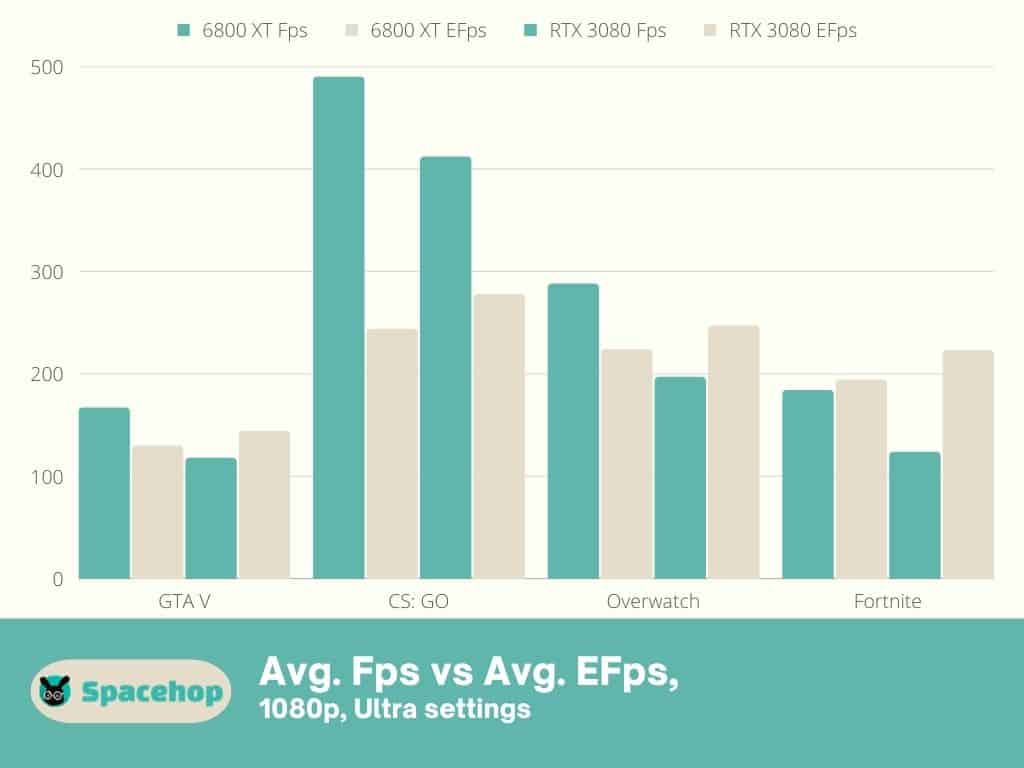
User tests paint a different picture. When comparing benchmark Fps with user EFps, the 3080 comes out 12% better at 1080p, and it has an effective speed advantage of up to 40% in some cases. The 3080’s average performance score according to user tests is 26% better than the 6800 XT’s.
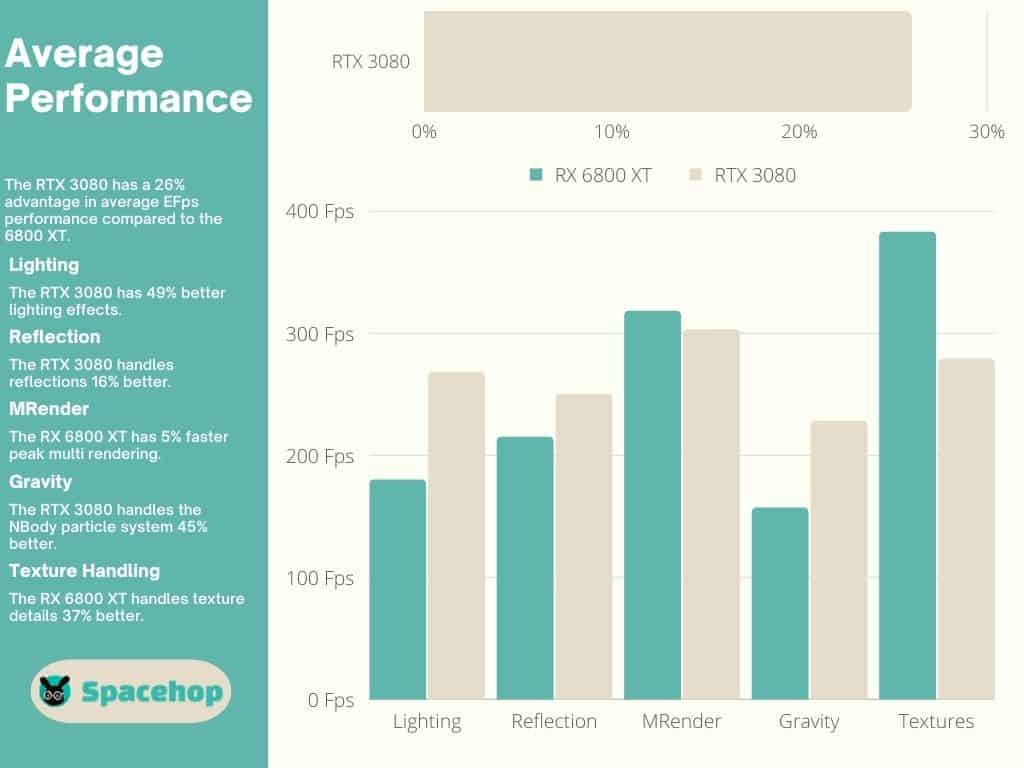
When overclocked, the RTX 3080 wins by 24%. The only segment in which the RX 6800 XT wins in texture details due to its slightly higher TMU count (288 vs 272).
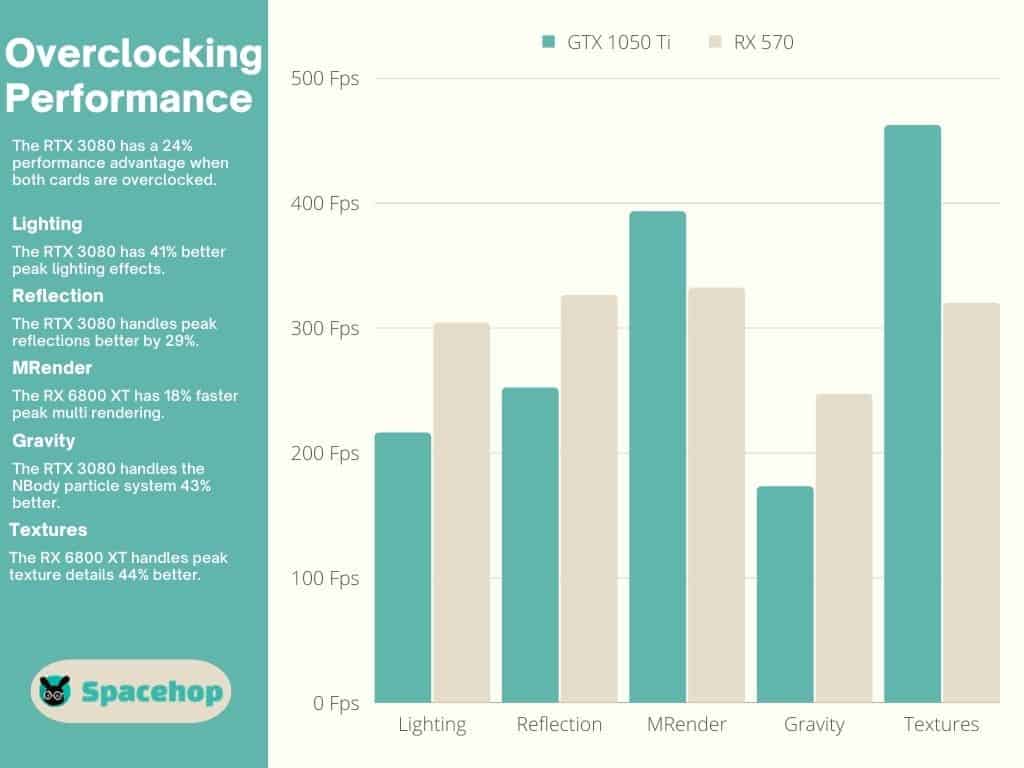
Winner: Nvidia GeForce RTX 3080
Connectivity
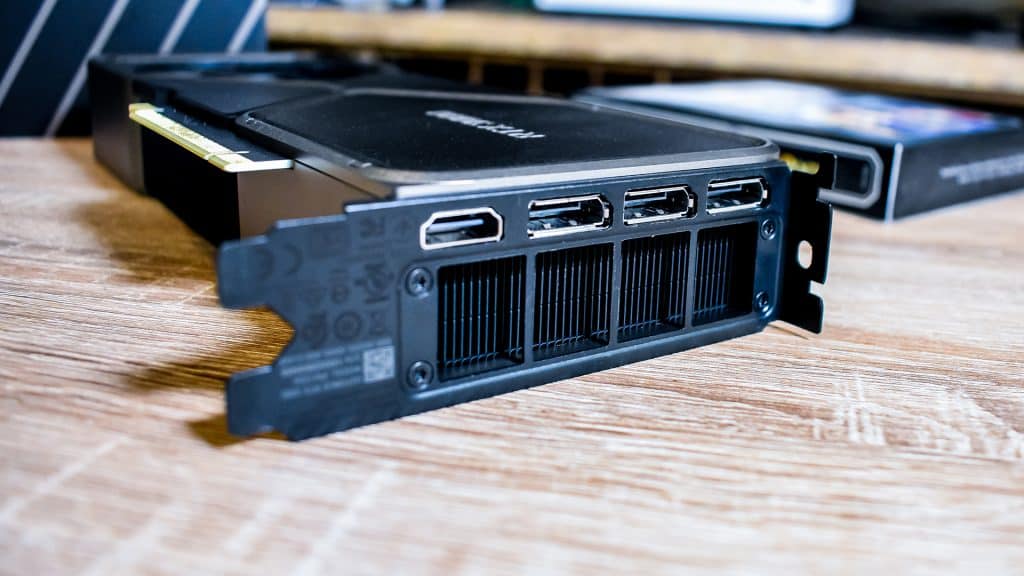
You can hook up four screens to the GeForce RTX 3080 via its three DisplayPorts and one HDMI 2.1 port. The Radeon RX 6800 XT also has one HDMI 2.1 port but only two DisplayPorts. You can still connect four screens to it as it also has a USB-C connector (via adaptors), something Nvidia dropped in the 3080 when compared to older models.
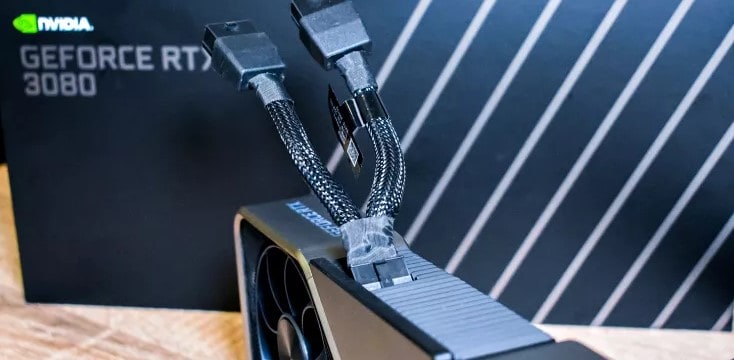
The Radeon RX 6800 XT has two standard 8-pin connectors on its side for power. The GeForce RTX 3080 cards have variants that use a 12-pin connector (adaptor required), 3 x 8-pin connectors, or just 2 x 8-pin connectors, depending on the third-party manufacturer (example here).
TDP
TDP refers to three terms: Thermal Design Power, Thermal Design Point, and Thermal Design Parameter, and these all mean the same thing. It most commonly refers to Thermal Design Power, so we’ll go with that.
TDP is a measurement of the maximum amount of heat generated by a CPU or GPU while handling intense workloads. We all know our PCs generate heat (hence the fans and coolers), and the more you push them, the hotter they get.
Nvidia states that TDP is also the maximum power a subsystem is allowed to draw and the maximum amount of heat generated by the component (as do many PC enthusiasts). The 3080 uses more power, maxing out at 320 W, while the 6800 XT uses 300 W.
In terms of heat, the 6800 XT averages out at 73 degrees Celsius, while the 3080 averages at 76 degrees (under load). This differs depending on actual load, clocking settings, PC case ventilation, and so on, but not by much.
Also Read: [Complete Guide] How to Undervolt your CPU and GPU [SAFE]
Winner: AMD Radeon RX 6800 XT
Design and Build
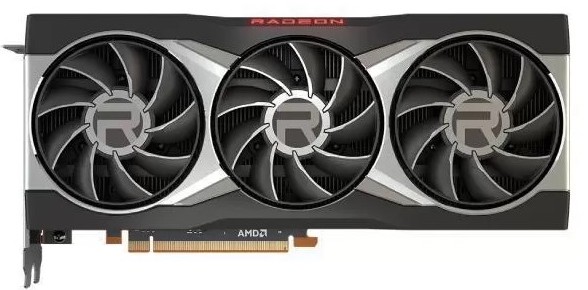
Choosing a graphics card isn’t about its aesthetic design, but build is important. The 6800 XT has no ventilation shafts on its rear end, so its three fans will deposit all of its heat into your case. Something to keep in mind when planning your new build or upgrading an existing one. Overall, the 6800 XT looks and feels like the premium product that it is.
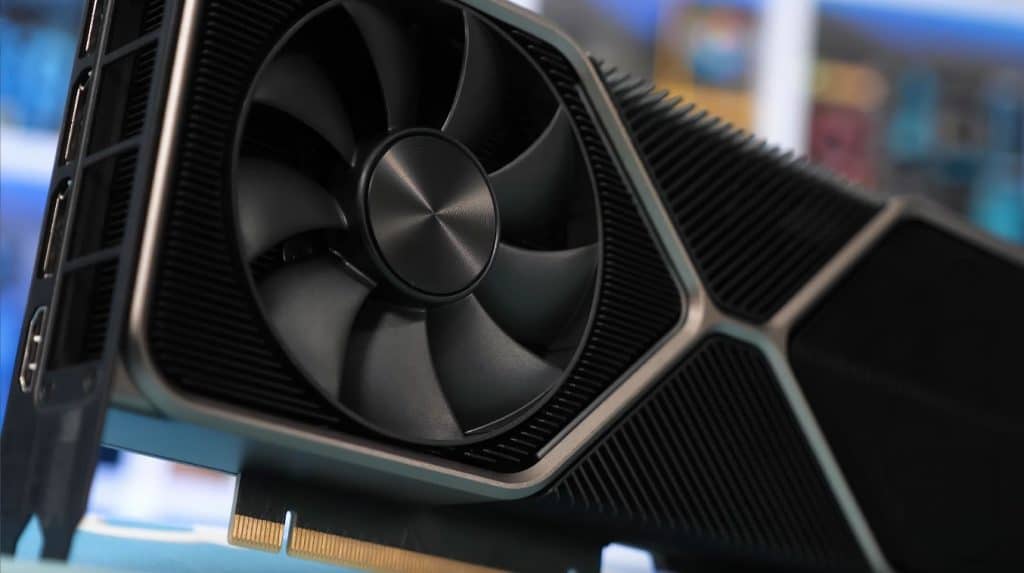
The same goes for the RTX 3080 in terms of look and feel. The Founders Edition featured a sleek design with two fans, one to push air straight through the card and out the other side, and another fan to vent air out through the back of the case. Third-party 3080 cards have since shown up with designs very similar to the 6800 XT in terms of fan numbers and positioning.
The 3080 Founders Edition had diagonally protruding pin connector slots, which turned out to be very convenient in builds as opposed to the straight positioning we are all used to on cards. Sadly, this trait didn’t transfer over to the design of third-party manufacturers.
Winner: Nvidia GeForce RTX 3080
Also Read: GPU Fans Not Spinning: Common causes and how to fix!
3080 vs 6800XT – Standout Features
RTX 3080 Tensor Cores
Tensor Cores are only found in Nvidia’s high-end products and professional GPUs (GeForce RTX series, Quadro RTX, and Titan family). The cores are processing units that accelerate matrix multiplication, offering improved performance in AI, gaming, and content creation. For a detailed explanation, read this.
Pricing & Availability
The starting prices of both of these cards were quite reasonable, considering their performance. The 3080 was first released for $699 but was sold out virtually overnight. The 6800 XT was released priced at $50 less than the 3080. But, you can’t find the Founders Editions of either of these cards anymore.
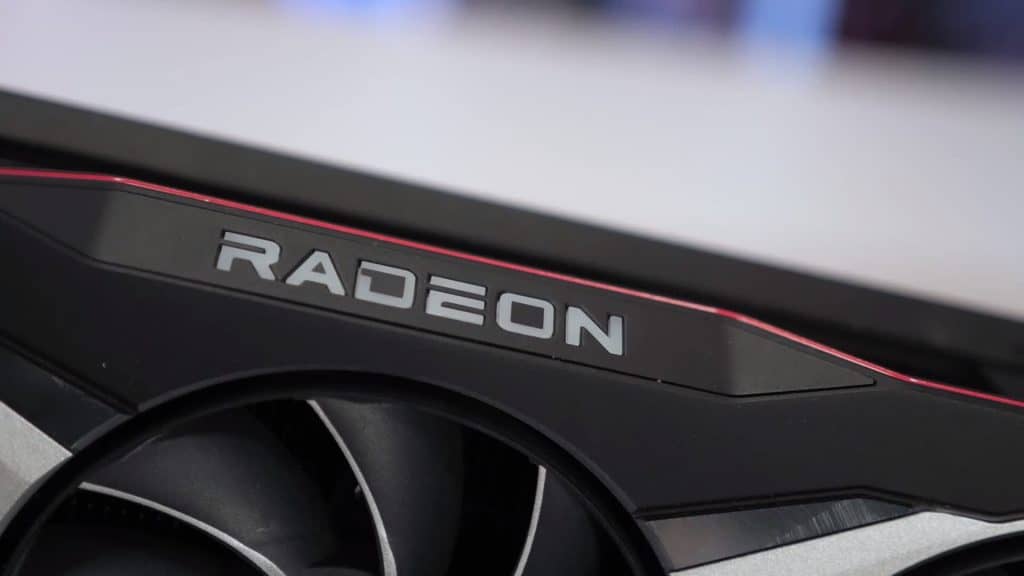
Enter third-party manufacturers. As with every component, there are versions from almost every manufacturer you can think of, and their prices differ depending on the bells and whistles they added to their version.
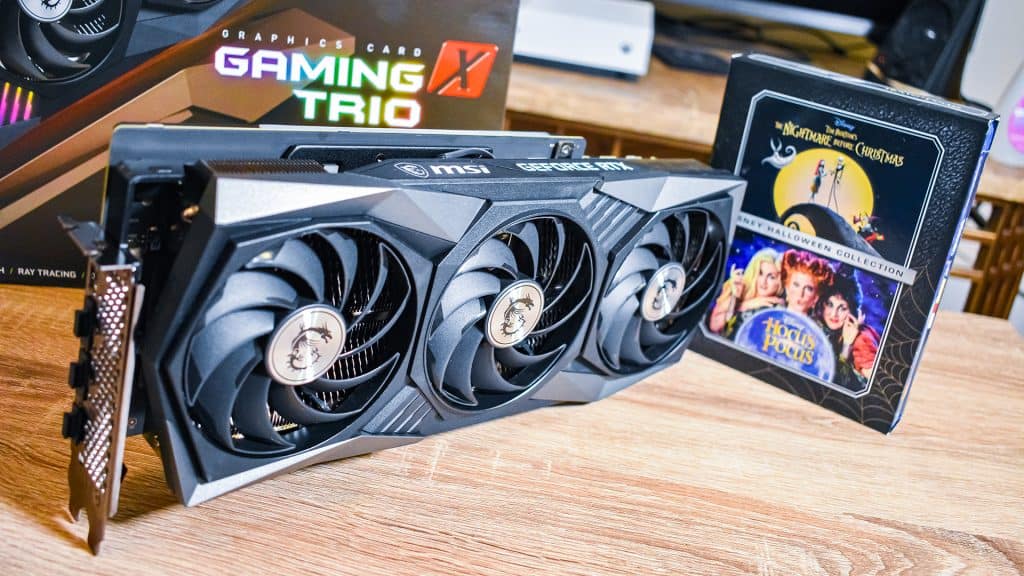
You can find an MSI Gaming Z variant of the RTX 3080 priced at 104% above MSRP or a regular MSI Gaming variant at the MSRP. The 6800 XT follows the same rules and can be found listed at 99% above MSRP for an XFX Speedster version, and 96% above for an MSI Gaming variant. Prices and supply fluctuate often for these GPUs.
*The listed percentages are subject to change and may differ at the time of reading.
Conclusion
When comparing the 6800XT vs 3080, we can all agree it was a tough choice when their prices differed more than they do now. With their prices pretty much leveled today, it comes down to what you’re looking for.
If you need a card that’s a long-term investment (remember the 16GB vs 10GB & 12GB) so that you’ll be able to handle ever more requirement-heavy games, the Radeon RT 6800 XT is your best bet, even if it lacks in Ray Tracing.
If you’re looking for the absolute best in 4K resolution when gaming, the GeForce RTX 3080 is your best bet. You’ll be able to max out the settings of every game currently under the sun, and it will still be like, “that’s it?!”. Also, all the Nvidia tech inside will keep you riding that wave for quite some time.